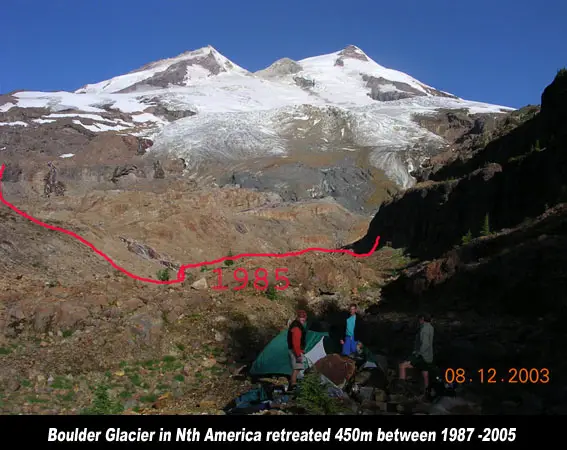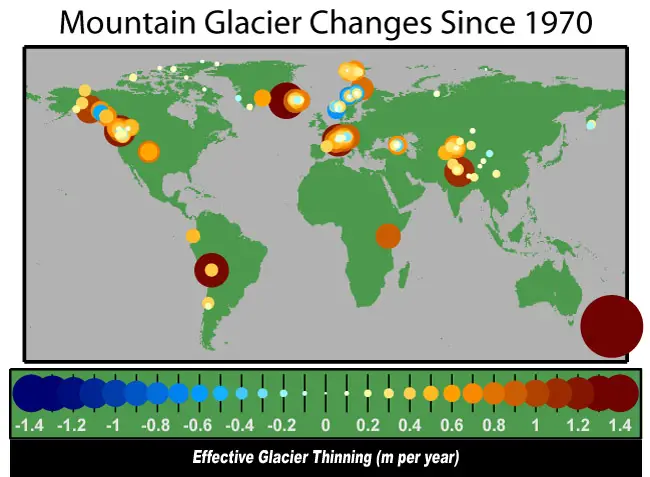Glacial retreat: “With few exceptions, all the alpine glaciers of the world are losing mass and it is predicted that this trend will continue as global warming progresses. Glaciers in alpine areas act as buffers. During the rainy season, water is stored in the glaciers and the melt water helps maintain river systems during dry periods. An estimated 1.5 to 2 billion people in Asia (Himalayan region) and in Europe (The Alps) and the Americas (Andes and Rocky Mountains) depend on river systems with glaciers inside their catchment areas. In areas where the glaciers are melting, river runoff will increase for a period before a sharp decline in runoff. Without the water from mountain glaciers, serious problems are inevitable and the UN’s Millennium Development Goals for fighting poverty and improving access to clean water will be jeopardized” United Nations Environment Programme, 2007 Global Outlook for Ice and Snow.
Glacial retreat since 1850 has been worldwide and rapid, affecting the availability of fresh water for irrigation and domestic use, mountain recreation, animals and plants. These all depend on glacier-melt, and in the longer term and to some extent so does the level of the oceans.
Studied by glaciologists, the coincidence of glacial retreat with the measured increase of atmospheric greenhouse gases is evidence underpinning anthropogenic climate change. Mid-latitude mountain ranges such as the Himalayas, Alps, Rocky Mountains, Cascade Range, Glacier National Park, and the southern Andes. This is also occurring in tropical glacier summits such as Mount Kilimanjaro in Africa, and Chacaltaya Glacier in Bolivia which are showing some of the largest proportionate glacial loss.
The Little Ice Age was a period from about 1550 to 1850 when the world experienced relatively cool temperatures compared to the present. Subsequently, until about 1940 glaciers around the world retreated as the climate warmed. Glacial retreat slowed and even reversed, in many cases, between 1950 and 1980 as a slight global cooling occurred. However, since 1980 a significant global warming has led to glacier retreat becoming increasingly rapid and ubiquitous, so much so that many glaciers have disappeared and the existence of a great number of the remaining glaciers of the world is threatened.

In locations such as the Andes of South America and Himalayas in Asia, the demise of glaciers in these regions will have potential impact on water supplies, and flooding from ‘mountain tsunamis’. The retreat of mountain glaciers, notably in western North America, Asia, the Alps, Indonesia and Africa, and tropical and subtropical regions of South America, has been used to provide qualitative evidence for the rise in global temperatures since the late 19th century. The recent substantial retreat and an acceleration of the rate of retreat since 1995 of a number of key outlet glaciers of the Greenland and West Antarctic ice sheets foreshadow a rise in sea level,having a potentially dramatic effect on coastal regions worldwide.
The continued glacial retreat will have a number of different quantitative impacts. In areas that are heavily dependent on water runoff from glaciers that melt during the warmer summer months, a continuation of the current retreat will eventually deplete the glacial ice and substantially reduce or eliminate runoff. A reduction in runoff will affect the ability to irrigate crops and will reduce summer stream flows necessary to keep dams and reservoirs replenished. This situation is particularly acute for irrigation in South America, where numerous artificial lakes are filled almost exclusively by glacial melt.
Central Asian countries have also been historically dependent on the seasonal glacier melt water for irrigation and drinking supplies. In Norway, the Alps, and the Pacific Northwest of North America, glacier runoff is important for hydropower.
The potential for major sea level rise depends mostly on a significant melting of the polar ice caps of Greenland and Antarctica, as this is where the vast majority of glacial ice is located.

See Also
